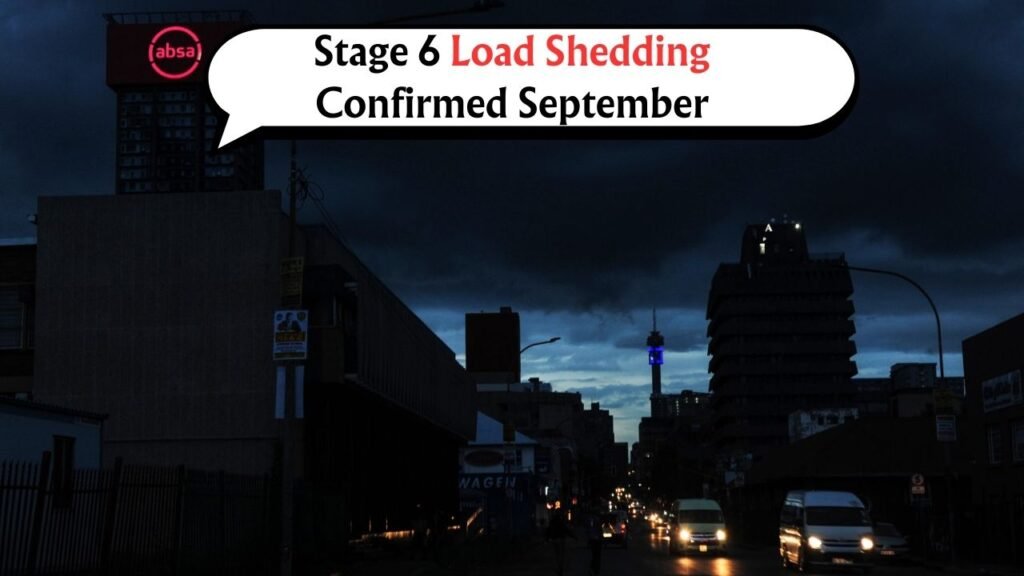Load Shedding Schedule – South Africans are bracing for one of the most severe electricity crises in recent history as the country enters Stage 6 load shedding this September 2025. The latest round of power cuts, announced by Eskom, marks a deepening of the nation’s ongoing energy struggle, affecting households, businesses, and essential services alike. With outages lasting up to six hours at a time in some regions, citizens are scrambling to adapt to this new, grueling reality. The disruption is particularly hard-hitting during peak hours, when demand surges and power availability dwindles. While authorities claim they’re working on mitigating the crisis, skepticism remains high. In a bid to help the public plan better, Eskom has released a detailed area-wise load shedding schedule, mapping out the blackout timings for every major province and municipality. As the country confronts yet another energy emergency, questions loom large about long-term infrastructure solutions and government accountability in averting such recurring disasters.

Why Stage 6 Load Shedding Is a Big Deal
Stage 6 load shedding is not just another technical term—it represents a serious degradation in South Africa’s power supply situation. Under this stage, Eskom is forced to remove up to 6,000 MW from the national grid, which results in more frequent and extended outages across the country. Unlike lower stages that may only impact a region for two hours a day, Stage 6 often means rolling blackouts lasting up to four or six hours at a time, sometimes multiple times in a single day. This kind of disruption has major consequences for the economy, especially for small businesses, manufacturers, and essential services like hospitals and water treatment facilities. Moreover, the inconvenience and strain placed on daily life are immense—from traffic chaos due to non-functional traffic lights to disruptions in remote working and online education. The gravity of Stage 6 lies in its frequency and unpredictability, leaving little room for recovery before the next outage strikes.

How Communities Are Coping with Prolonged Blackouts
As blackouts grow longer and more frequent, communities across South Africa are finding creative and sometimes desperate ways to cope. In urban centers, residents are investing in backup power systems such as inverters, solar panels, and generators. Those who can’t afford such solutions are adjusting their routines to work around blackout schedules—cooking meals in advance, charging devices during power hours, and using public places with electricity to complete tasks. In rural areas, the impact is even harsher due to limited infrastructure and resources. Community-led initiatives have emerged to support the most vulnerable, such as food drives and neighborhood watch groups to increase safety during dark hours. Businesses, too, are adapting by revising operating hours or transitioning to off-grid alternatives. Despite these efforts, the general mood remains one of frustration and fatigue. Many fear that unless meaningful reform takes place, load shedding will only worsen, further threatening livelihoods and social stability.
Full Area-Wise Load Shedding Schedule Now Available
To help South Africans prepare for the worst, Eskom has published a comprehensive area-wise schedule for Stage 6 load shedding. This document outlines the exact times and dates when each neighborhood or region will experience power cuts. Available both online and through local municipal offices, the schedule aims to bring some level of predictability to an otherwise chaotic situation. Major metros like Johannesburg, Cape Town, and Durban have already begun circulating tailored schedules to help residents plan their days. For example, residents in Pretoria may face blackouts between 4 p.m. and 10 p.m., while those in Port Elizabeth could be without power from 6 a.m. to noon. While the schedule is a useful tool, many complain that it’s often unreliable due to sudden changes in the grid’s stability. Still, it remains a crucial resource in a time when even a few hours of preparedness can make a significant difference in navigating daily life.
What’s Being Done to Fix the Power Crisis?
The South African government and Eskom have faced mounting pressure to address the ongoing energy crisis. Officials claim that emergency repairs, international energy partnerships, and increased investment in renewable sources are underway. However, progress has been slow, and many citizens doubt whether current efforts will bring lasting change. Independent power producers have been encouraged to contribute to the grid, and there’s talk of reducing red tape to speed up solar and wind projects. Yet, critics argue that deep-rooted issues like corruption, mismanagement, and lack of foresight continue to plague the sector. Meanwhile, energy experts warn that unless large-scale infrastructural upgrades are made soon, the country may face even more extreme stages of load shedding in the future. In the short term, the focus remains on stabilizing the grid and avoiding a total collapse. But for many South Africans, hope is fading as they endure another round of nationwide darkness with no clear end in sight.
What impact do the scheduled blackouts have on South Africa's residents?
Residents face challenges with electricity availability due to planned power outages.




